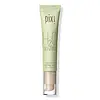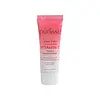What's inside
What's inside
 Key Ingredients
Key Ingredients

 Benefits
Benefits

 Concerns
Concerns

 Ingredients Side-by-side
Ingredients Side-by-side

Water
Skin ConditioningCyclopentasiloxane
Emollient1,2-Hexanediol
Skin ConditioningHexyl Laurate
EmollientGlycerin
HumectantPEG-10 Dimethicone/Vinyl Dimethicone Crosspolymer
StabilisingRosa Centifolia Flower Water
Skin ConditioningAnthemis Nobilis Flower Extract
MaskingLavandula Angustifolia Extract
Skin ConditioningCamellia Sinensis Leaf Extract
AntimicrobialPortulaca Oleracea Extract
Skin ConditioningTocopherol
AntioxidantDimethicone
EmollientCetyl PEG/PPG-10/1 Dimethicone
EmulsifyingPEG-10 Dimethicone Crosspolymer
StabilisingTriethoxycaprylylsilane
Aluminum Hydroxide
EmollientSodium Chloride
MaskingEthylhexylglycerin
Skin ConditioningCyclotetrasiloxane
EmollientPhenoxyethanol
PreservativeCI 77891
Cosmetic ColorantIron Oxides
Water, Cyclopentasiloxane, 1,2-Hexanediol, Hexyl Laurate, Glycerin, PEG-10 Dimethicone/Vinyl Dimethicone Crosspolymer, Rosa Centifolia Flower Water, Anthemis Nobilis Flower Extract, Lavandula Angustifolia Extract, Camellia Sinensis Leaf Extract, Portulaca Oleracea Extract, Tocopherol, Dimethicone, Cetyl PEG/PPG-10/1 Dimethicone, PEG-10 Dimethicone Crosspolymer, Triethoxycaprylylsilane, Aluminum Hydroxide, Sodium Chloride, Ethylhexylglycerin, Cyclotetrasiloxane, Phenoxyethanol, CI 77891, Iron Oxides
Water
Skin ConditioningGlycerin
HumectantMethyl Trimethicone
Skin ConditioningPhenyl Trimethicone
Skin ConditioningNeopentyl Glycol Dicaprate
EmollientZinc Oxide
Cosmetic ColorantCetyl PEG/PPG-10/1 Dimethicone
EmulsifyingSorbitan Sesquioleate
EmulsifyingTribehenin
EmollientLauryl PEG-10 Tris(Trimethylsiloxy)Silylethyl Dimethicone
EmulsifyingCaprylic/Capric Triglyceride
MaskingDimethicone
EmollientStearalkonium Hectorite
Gel FormingDimethicone/Polyglycerin-3 Crosspolymer
CleansingCaprylyl Glycol
EmollientSphingomonas Ferment Extract
Skin ConditioningPentylene Glycol
Skin ConditioningEthylhexylglycerin
Skin ConditioningButylene Glycol
HumectantTriethoxycaprylylsilane
Dipropylene Glycol
HumectantSodium Citrate
Buffering1,2-Hexanediol
Skin ConditioningAscorbic Acid
AntioxidantFragaria Chiloensis Fruit Extract
Skin ConditioningVaccinium Angustifolium Fruit Extract
Skin ProtectingVitis Vinifera Fruit Extract
Skin ConditioningTocopherol
AntioxidantVaccinium Macrocarpon Fruit Extract
AstringentSambucus Nigra Fruit Extract
AstringentRubus Fruticosus Fruit Extract
AstringentEuterpe Oleracea Fruit Extract
Polyglyceryl-10 Laurate
Skin ConditioningLycium Chinense Fruit Extract
AntioxidantGardenia Jasminoides Fruit Extract
Cosmetic ColorantBacillus Ferment
Skin ConditioningCornus Officinalis Fruit Extract
Skin ConditioningCrataegus Oxyacantha Fruit Extract
Skin ConditioningSchisandra Chinensis Fruit Extract
Skin ConditioningChamomilla Recutita Extract
Skin ConditioningJasminum Officinale Extract
MaskingLavandula Angustifolia Extract
Skin ConditioningMelilotus Officinalis Extract
AstringentMentha Viridis Extract
MaskingRosa Canina Fruit Extract
AstringentRosmarinus Officinalis Leaf Extract
AntimicrobialSalvia Officinalis Extract
AntimicrobialPalmitoyl Pentapeptide-4
Skin ConditioningHexapeptide-9
Skin ConditioningAcetyl Hexapeptide-8
HumectantCopper Tripeptide-1
Skin ConditioningTripeptide-1
Skin ConditioningCI 77891
Cosmetic ColorantCI 77491
Cosmetic ColorantCI 77492
Cosmetic ColorantCI 77499
Cosmetic ColorantWater, Glycerin, Methyl Trimethicone, Phenyl Trimethicone, Neopentyl Glycol Dicaprate, Zinc Oxide, Cetyl PEG/PPG-10/1 Dimethicone, Sorbitan Sesquioleate, Tribehenin, Lauryl PEG-10 Tris(Trimethylsiloxy)Silylethyl Dimethicone, Caprylic/Capric Triglyceride, Dimethicone, Stearalkonium Hectorite, Dimethicone/Polyglycerin-3 Crosspolymer, Caprylyl Glycol, Sphingomonas Ferment Extract, Pentylene Glycol, Ethylhexylglycerin, Butylene Glycol, Triethoxycaprylylsilane, Dipropylene Glycol, Sodium Citrate, 1,2-Hexanediol, Ascorbic Acid, Fragaria Chiloensis Fruit Extract, Vaccinium Angustifolium Fruit Extract, Vitis Vinifera Fruit Extract, Tocopherol, Vaccinium Macrocarpon Fruit Extract, Sambucus Nigra Fruit Extract, Rubus Fruticosus Fruit Extract, Euterpe Oleracea Fruit Extract, Polyglyceryl-10 Laurate, Lycium Chinense Fruit Extract, Gardenia Jasminoides Fruit Extract, Bacillus Ferment, Cornus Officinalis Fruit Extract, Crataegus Oxyacantha Fruit Extract, Schisandra Chinensis Fruit Extract, Chamomilla Recutita Extract, Jasminum Officinale Extract, Lavandula Angustifolia Extract, Melilotus Officinalis Extract, Mentha Viridis Extract, Rosa Canina Fruit Extract, Rosmarinus Officinalis Leaf Extract, Salvia Officinalis Extract, Palmitoyl Pentapeptide-4, Hexapeptide-9, Acetyl Hexapeptide-8, Copper Tripeptide-1, Tripeptide-1, CI 77891, CI 77491, CI 77492, CI 77499
Ingredients Explained
These ingredients are found in both products.
Ingredients higher up in an ingredient list are typically present in a larger amount.
1,2-Hexanediol is a synthetic liquid and another multi-functional powerhouse.
It is a:
- Humectant, drawing moisture into the skin
- Emollient, helping to soften skin
- Solvent, dispersing and stabilizing formulas
- Preservative booster, enhancing the antimicrobial activity of other preservatives
This ingredient is a high molecular weight silicone. It has emulsifying and skin conditioning properties.
Ci 77891 is a white pigment from Titanium dioxide. It is naturally found in minerals such as rutile and ilmenite.
It's main function is to add a white color to cosmetics. It can also be mixed with other colors to create different shades.
Ci 77891 is commonly found in sunscreens due to its ability to block UV rays.
Learn more about CI 77891Dimethicone is a type of synthetic silicone created from natural materials such as quartz.
What it does:
Dimethicone comes in different viscosities:
Depending on the viscosity, dimethicone has different properties.
Ingredients lists don't always show which type is used, so we recommend reaching out to the brand if you have questions about the viscosity.
This ingredient is unlikely to cause irritation because it does not get absorbed into skin. However, people with silicone allergies should be careful about using this ingredient.
Note: Dimethicone may contribute to pilling. This is because it is not oil or water soluble, so pilling may occur when layered with products. When mixed with heavy oils in a formula, the outcome is also quite greasy.
Learn more about DimethiconeEthylhexylglycerin (we can't pronounce this either) is commonly used as a preservative and skin softener. It is derived from glyceryl.
You might see Ethylhexylglycerin often paired with other preservatives such as phenoxyethanol. Ethylhexylglycerin has been found to increase the effectiveness of these other preservatives.
Glycerin is already naturally found in your skin. It helps moisturize and protect your skin.
A study from 2016 found glycerin to be more effective as a humectant than AHAs and hyaluronic acid.
As a humectant, it helps the skin stay hydrated by pulling moisture to your skin. The low molecular weight of glycerin allows it to pull moisture into the deeper layers of your skin.
Hydrated skin improves your skin barrier; Your skin barrier helps protect against irritants and bacteria.
Glycerin has also been found to have antimicrobial and antiviral properties. Due to these properties, glycerin is often used in wound and burn treatments.
In cosmetics, glycerin is usually derived from plants such as soybean or palm. However, it can also be sourced from animals, such as tallow or animal fat.
This ingredient is organic, colorless, odorless, and non-toxic.
Glycerin is the name for this ingredient in American English. British English uses Glycerol/Glycerine.
Learn more about GlycerinLavandula Angustifolia Extract comes from the lavender flower. Lavandula Angustifolia is known as the English Lavender and famous for creating purple fields in Provence, France.
Lavandula Angustifolia Extract has anti-inflammatory properties due to its prostanoids and histamine content. Lavender also contains flavonoids and phenolic acids (such as ferulic acid), potent antioxidants.
Lavender extract may have a scent. It contains linalool, a known allergen. However, lavender extract contains less linalool than lavender essential oil.
Learn more about Lavandula Angustifolia ExtractTocopherol (also known as Vitamin E) is a common antioxidant used to help protect the skin from free-radicals and strengthen the skin barrier. It's also fat soluble - this means our skin is great at absorbing it.
Vitamin E also helps keep your natural skin lipids healthy. Your lipid skin barrier naturally consists of lipids, ceramides, and fatty acids. Vitamin E offers extra protection for your skin’s lipid barrier, keeping your skin healthy and nourished.
Another benefit is a bit of UV protection. Vitamin E helps reduce the damage caused by UVB rays. (It should not replace your sunscreen). Combining it with Vitamin C can decrease sunburned cells and hyperpigmentation after UV exposure.
You might have noticed Vitamin E + C often paired together. This is because it is great at stabilizing Vitamin C. Using the two together helps increase the effectiveness of both ingredients.
There are often claims that Vitamin E can reduce/prevent scarring, but these claims haven't been confirmed by scientific research.
Learn more about TocopherolTriethoxycaprylylsilane is a silicone used to bind and stabilize ingredients.
As an emulsifier, it helps prevent ingredients from separating. This can help elongate the shelf life of products.
Triethoxycaprylylsilane is often used to coat mineral sunscreens ingredients to help give a better feel. It also helps reduce oxidative stress in sunscreens.
Learn more about TriethoxycaprylylsilaneWater. It's the most common cosmetic ingredient of all. You'll usually see it at the top of ingredient lists, meaning that it makes up the largest part of the product.
So why is it so popular? Water most often acts as a solvent - this means that it helps dissolve other ingredients into the formulation.
You'll also recognize water as that liquid we all need to stay alive. If you see this, drink a glass of water. Stay hydrated!
Learn more about Water